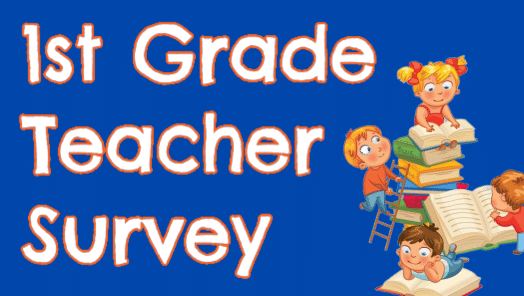Teacher Survey: 1st Grade Reading Level
Here are the key findings from our survey of 500+ first grade teachers.
Key Finding #1: 52% of first grade students are reading below the first grade reading level
For reference, this is not a quantitative or academic measure of a student’s reading level, but is instead the opinion of first grade teachers based on anecdotal evidence and experience. Nonetheless, with years of experience, the opinions of actual first grade teachers carries a lot of weight, and these results are a little concerning. According to this group of first grade teachers, over half of American first graders are struggling with their reading skills.
Key Finding #2: Only 28% of parents are doing enough with their children to help develop their reading skills
Clearly the term “doing enough” is a subjective measure and is based on the perceptions of individual teachers. However, once again trusting the opinions of teachers, the results seem to be an indictment of American parents. Less than 30% of first grade parents are sufficiently involved in the development of their child’s reading abilities at home. For reference, our survey did not explore the underlying reasons for such shortcomings (such as parents being too busy or relying too much on their child’s school). However, it is evident that first grade parents must become more actively involved in the development of their child’s reading skills.
Key Finding #3: 63% of teachers believe setting aside time each day to read with your first grader is the best means of improving their reading abilities
As part of our survey, we asked teachers what they believed was the most effective method for parents to work with their children to improve their reading skills. We presented the teachers with a list of five options covering a diverse set of strategies. Overwhelmingly, our group of surveyed teachers believes that setting aside time each day to read with a child is the most effective means of improving their skills. The collective opinion appears to be that simple time spent together reading and practicing phonics is more effective than tutoring, vocabulary expansion, increasing engagement with more interesting books, and reducing distractions.
1st Grade Reading Level Examples & Explainer
There is no standard definition for the first grade reading level. Though somewhat frustrating, it is a rather amorphous concept, and there is not a clear cut definition by which to measure and gauge your student’s readiness. As your child enters first grade, their expected reading skills and abilities will vary by school district, and sometimes, even on a class-by-class basis.
However, there are certain milestones your child should be hitting and indicators that your child is making proper progress. Let’s discuss those below:
- Decoding Skills: By first grade, students should be more proficient at decoding, which is based largely on phonics principles. This involves recognizing and sounding out individual letters and letter combinations. You should see your child begin to understand the relationship between letters and the sounds they represent. Decoding should start with CVC words (e.g., “bat,” “bag,” “can,” etc.), before moving on to CVCe words.
- Sight Words: First graders should be picking up common sight words. These are common words that children recognize instantly without sounding them out. These high-frequency words (such as “the,” “and,” and “of”) are often not easily decodable. These words are learned by sight and memorized.
- Reading Comprehension: Early in first grade, reading comprehension is often focused on basic understanding of text. As your child progresses through the school year, they should start making connections between what they read and their own experiences. They should begin to infer information from the text.
- Vocabulary Development: First graders should experience rapid vocabulary expansion during the school year. As students encounter new words in their reading, their vocabulary should naturally expand. Moreover, teachers should and often do incorporate vocabulary-building activities into class to enhance children’s word base.
- Simple Sentences and Stories: First grade reading materials are typically identified by simple sentences and short stories with basic plots. The complexity of such stories and books should increase gradually as the school year progresses. Some advanced students may even start to read basic chapter books during the school year.
- Illustrations: Graphics, illustrations and pictures are often included in first grade reading materials to aid students in understanding the text they read. The idea is to help them help visualize what they read, and encourage them to make connections between words and the images.
- Engagement and Enjoyment: Reading in the first grade should be fun and engaging. Teachers should use a variety of approaches to foster the fun factor, including reading aloud, group reading activities, and participative discussions.
Please keep in mind that children develop at different rates, and some students may progress more quickly or slowly than their peers. Do not fret if you feel that your child is falling behind. Teachers and school districts will use a variety of assessments (such as Lexile levels) to gauge individual progress, as well as provide targeted support where needed.
1st Grade Reading Books, Passages & Worksheets
The best place to find books, worksheets and reading passages for your first grader is your child’s school. Obviously, there are thousands of books and worksheets you can purchase through Amazon, Scholastic and Teachers Pay Teachers; however, there is no better resource than your student’s teacher and school librarian.
Assuming your son or daughter’s teacher is experienced and has been afforded an adequate opportunity to work with and gauge your child, they should be well be equipped to make recommendations and provide resources. Moreover, elementary school librarians are specially trained to provide tailored resources based on consultation with teachers and parents.
Moreover, not only are such resources tailored for your student’s needs based on professional advice, but such resources are also 100% free. It is our recommendation that you start with your school librarian and teacher before dropping hundreds of dollars on commercial materials.
Methodology
All data found within this report derives from a survey commissioned by TestPrepInsight.com. In total, 503 first grade teachers were surveyed across 34 states (working at both public and private schools).
All respondents were asked to answer questions truthfully and to the best of their abilities, with assurances that their identity would remain confidential. Any questions can be directed to info@testprepinsight.com.

